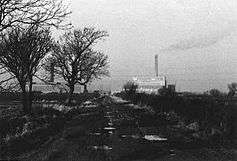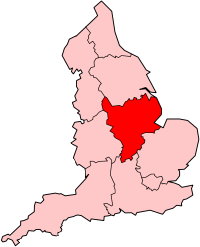Staythorpe Power Station
Staythorpe C Power Station is a 1,735 MWe gas-fired power station between Southwell and Newark-on-Trent in Nottinghamshire, England, between the River Trent and Nottingham to Lincoln railway line. The station was handed over to the owner RWE npower from Alstom Power with full commercial operation being achieved in December 2010. The official opening ceremony attended by Charles Hendry, Minister of State took place on 9 May 2011.
| Staythorpe Power Station | |
|---|---|
 Staythorpe power station under construction in April 2009 | |

| |
| Country | England |
| Location | Nottinghamshire, East Midlands |
| Coordinates | 53.07482°N 0.85573°W |
| Commission date | 2010 |
| Construction cost | £600 million |
| Operator(s) | RWE npower (2010-) |
| Thermal power station | |
| Primary fuel | Natural gas |
| External links | |
| Commons | Related media on Commons |
grid reference SK767536 | |
The £680 million plant near Averham was formally opened on 9 May 2011 and is owned by the German energy company, RWE npower. It is the second largest Combined Cycle Gas Turbine (CCGT) power station in the UK and has an overall efficiency in excess of 58%.
History
Former power stations

Staythorpe C was built on the site of two former CEGB coal-fired power stations, the 360 MW Staythorpe A and the 360 MW Staythorpe B.[1]
Staythorpe A was authorised in 1946 and commenced by Derbyshire & Nottinghamshire Electric Power Company. In 1948, electricity supply was nationalised, and the station became the responsibility of the British Electricity Authority (1948-1955) then the Central Electricity Authority (1955-1957) and finally the Central Electricity Generating Board (1958-1990). Staythorpe A was first commissioned in March 1950. It had six 60 MW British Thomson-Houston turbo-alternators giving a gross capability of 360 MW and a net generating capability of 336 MW. The second set was commissioned in July 1950, followed by the other units in April 1952, December 1953, December 1955 and August 1956.[2] The 16 coal-fired Babcock and Wilcox CTM Highhead spreader stoker boilers produced a maximum of 480 kg/s of steam delivered to the turbines at 62.1 bar and 482°C.[3] Cooling of the station was by river water. The station had three chimneys.
The electricity output, in GWh, is shown in the graph and the installed capacity and output of the power station are shown in the table.[3][2][4][5][6]

| Year | 1954 | 1955 | 1956 | 1957 | 1958 | 1961 | 1962 | 1963 | 1971 | 1979 | 1981 | 1982 |
|---|---|---|---|---|---|---|---|---|---|---|---|---|
| Installed capacity, MW | 224 | 224 | 284 | 336 | 336 | 336 | 336 | 360 | 360 | 360 | 336 | 112 |
| Electricity output, GWh | 963.651 | 1,405.848 | 1,531.189 | 1,781.554 | 2,079.335 | 1731 | 1718 | 1692 | 854.113 | 282.42 | 98.231 | 34.755 |
The station was closed on 31 October 1983[7] and had a generating capacity of 112 MW.[8]
Staythorpe B was commissioned in May 1962 by the Central Electricity Generating Board. It had three 120 MW Metropolitan Vickers turbo-alternators giving a gross generating capability of 360 MW and a net capability of 336 MW. The John Brown pulverised fuel boilers produced a maximum of 324 kg/s of steam delivered to the turbines at 103.4 bar and 538°C.[3] Staythorpe B was one of the CEGB’s twenty steam power stations with the highest thermal efficiency; in 1963–4 the thermal efficiency was 33.28 per cent, 33.54 per cent in 1964–5, and 33.83 per cent in 1965–6.[9] Cooling of the station was by river water and cooling towers constructed by Davenport Engineering. The station had a single chimney. The annual electricity output of Staythorpe B was:[9][10]
| Year | 1960–1 | 1961–2 | 1962–3 | 1963–4 | 1964–5 | 1965–6 | 1971–2 | 1978–9 | 1980–1 | 1981–2 |
|---|---|---|---|---|---|---|---|---|---|---|
| Electricity output, GWh | 379 | 1191 | 2438 | 2,455 | 2,211 | 2,192 | 2,203 | 1,967 | 1,962.6 | 1,811 |
Staythorpe B closed in 1994[7] with a generating capacity of 354 MW.[11]
There is still a large substation next to the site of the former power stations, and a monument. Staythorpe B power station was supplied with coal via a branch off the adjacent Nottingham and Lincoln railway line. Rail facilities included a west-facing junction on the mainline, eleven sidings, a coal hopper, a locomotive shed and a run-round loop.[12]
The cooling water system enabled the abstraction of up to 104,600 m3/h (23 million gallons per hour) of water from the River Trent.[13]
Planning process
Planning permission was given for the gas-fired power station as early as 1993, and construction originally began in 1998 by the previous owner National Power, temporarily ceasing in 2000 due to market saturation and low returns on electricity generation (high gas costs versus low electricity prices). Construction restarted in early 2008, after RWE decided to proceed with Staythorpe in May 2007 in preference to development at an alternate site in Pembrokeshire Pembroke.[14] The Pembrokeshire site was given the go ahead to proceed alongside Staythorpe in February 2009 once environmental conditions were assured to be met. The project at Staythorpe will be constructed under an Engineering, procurement and construction (EPC) contract by Alstom Power.
Alstom Power Ltd, the construction contractors, applied to Newark and Sherwood District Council in October 2008 for planning permission to develop an additional storage depot immediately adjacent to the village of Staythorpe.[15] Many villagers have expressed concern about this and a campaign to oppose it has been set up.
It is situated around one mile from Newark, between the villages of Averham, to the north, and Farndon, to the south with the address Staythorpe Road, Staythorpe, NG23 5PS. The north-east section of the power station is in the Averham parish, with the rest in Staythorpe.
The electricity 400 kV ZA transmission line from Staythorpe to Grendon, Northamptonshire is being upgraded to prepare for the new power station.
Resourcing of construction labour
The GMB and Unite trade unions demonstrated at the station when Alstom recruited non-UK contract labour to build the power station.[16]
Specification

Staythorpe is a CCGT power station that runs primarily on natural gas, but has the theoretical (not commissioned) option to switch to (distillate) light fuel oil. It was designed to generate enough electricity for two million homes with four KA26-1 modules each generating around 430 MWe, each with an Alstom 288 MWe GT26B gas turbine, triple-pressure heat recovery steam generator and steam turbine.[17] Electricity is generated using Alstom TOPGAS hydrogen-cooled generators.[18] The plant was designed for a thermal efficiency of around 58%.
References
- http://www.npower.com/prod_consuma/groups/wcms_content/@wcms/@micr/documents/microsites/wcms_006007.jpg
- Garrett, Frederick C. (ed) (1959). Garcke's Manual of Electricity Supply. London: Electrical Press. pp. A-96, A-134.CS1 maint: extra text: authors list (link)
- CEGB (1981). CEGB statistical Yearbook 1980-81. London: CEGB. p. 7.
- CEGB (1972). CEGB Statistical Yearbook 1972. London: CEGB. p. 13.
- CEGB (1982). CEGB Statistical Yearbook 1981-82. London: CEGB. p. 7. ISBN 0902543695.
- CEGB Annual report and Accounts, 1961, 1962 & 1963
- "Staythorpe power stations". Grace's Guide to British Industrial History. 21 November 2018. Retrieved 5 February 2020.
- Mr. Redmond (16 January 1984). "Coal-fired Power Stations". Hansard. Retrieved 1 September 2009.
- CEGB (1966). CEGB Statistical Yearbooks 1964, 1965, 1966, 1972, 1982. London: CEGB. p. 20.
- CEGB Annual report and Accounts, 1961, 1962 & 1963
- "Generation disconnections since 1991". National Grid plc. 2003. Archived from the original on 8 May 2003. Retrieved 5 October 2009.
- Jacobs, Gerald (1990). London Midland Region Track Diagrams. Exeter: Quail. pp. 6B. ISBN 0900609745.
- Sheail, John (1991). Power in Trust. Oxford: Clarendon Press. p. 65. ISBN 0-19-854673-4.
- http://www.rwe.com/generator.aspx/konzern/verantwortung/aktuelles/2007/0530/language=en/id=476940/page.html
- http://www.nsdc.info/eplanning/default.aspx?sid=1&sindex=1&id=2&refno=08/02006/FULM
- "Sustained demonstrations will continue outside Staythorpe power station". Unite. 28 January 2009. Retrieved 28 June 2012.
- http://www.power.alstom.com/home/equipment___systems/turbines/gas_turbines/gt24_and_gt26___188mw_and_281mw_/34621.EN.php?languageId=EN&dir=/home/equipment___systems/turbines/gas_turbines/gt24_and_gt26___188mw_and_281mw_/
- http://www.power.alstom.com/home/equipment___systems/generators/turbogenerators/topgas/6582.EN.php?languageId=EN&dir=/home/equipment___systems/generators/turbogenerators/topgas/
External links
| Wikimedia Commons has media related to Staythorpe Power Station. |

